engine YAMAHA T110C 2014 User Guide
[x] Cancel search | Manufacturer: YAMAHA, Model Year: 2014, Model line: T110C, Model: YAMAHA T110C 2014Pages: 82, PDF Size: 2.06 MB
Page 23 of 82
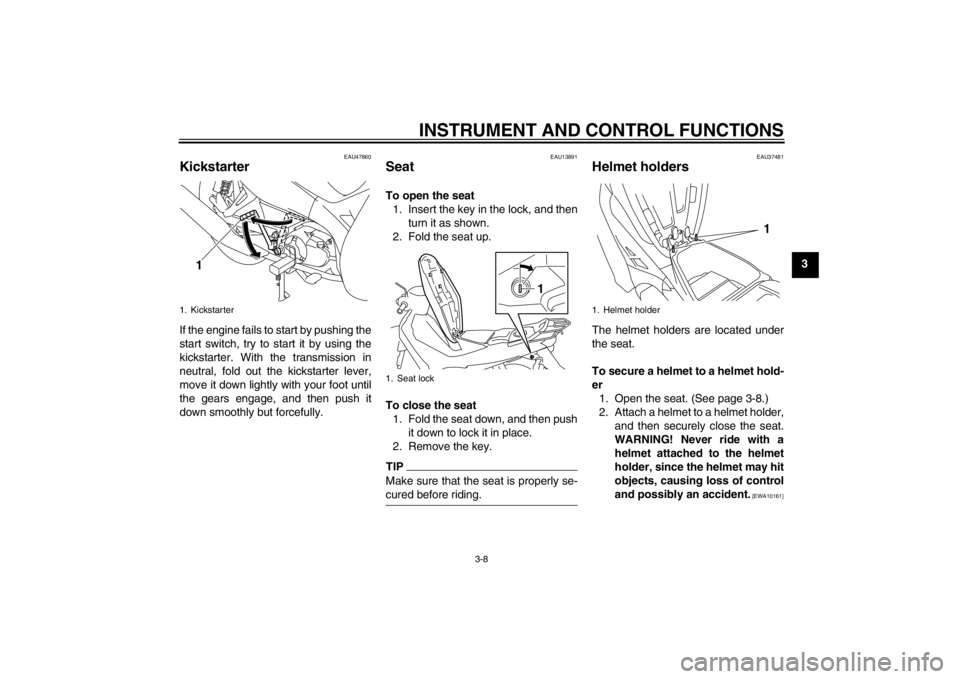
INSTRUMENT AND CONTROL FUNCTIONS
3-8
3
EAU47860
Kickstarter If the engine fails to start by pushing the
start switch, try to start it by using the
kickstarter. With the transmission in
neutral, fold out the kickstarter lever,
move it down lightly with your foot until
the gears engage, and then push it
down smoothly but forcefully.
EAU13891
Seat To open the seat
1. Insert the key in the lock, and then
turn it as shown.
2. Fold the seat up.
To close the seat
1. Fold the seat down, and then push
it down to lock it in place.
2. Remove the key.TIPMake sure that the seat is properly se-
cured before riding.
EAU37481
Helmet holders The helmet holders are located under
the seat.
To secure a helmet to a helmet hold-
er
1. Open the seat. (See page 3-8.)
2. Attach a helmet to a helmet holder,
and then securely close the seat.
WARNING! Never ride with a
helmet attached to the helmet
holder, since the helmet may hit
objects, causing loss of control
and possibly an accident.
[EWA10161]
1. Kickstarter
1
1. Seat lock
1
1. Helmet holder
1
U40BE2E0.book Page 8 Wednesday, October 10, 2012 8:01 AM
Page 26 of 82
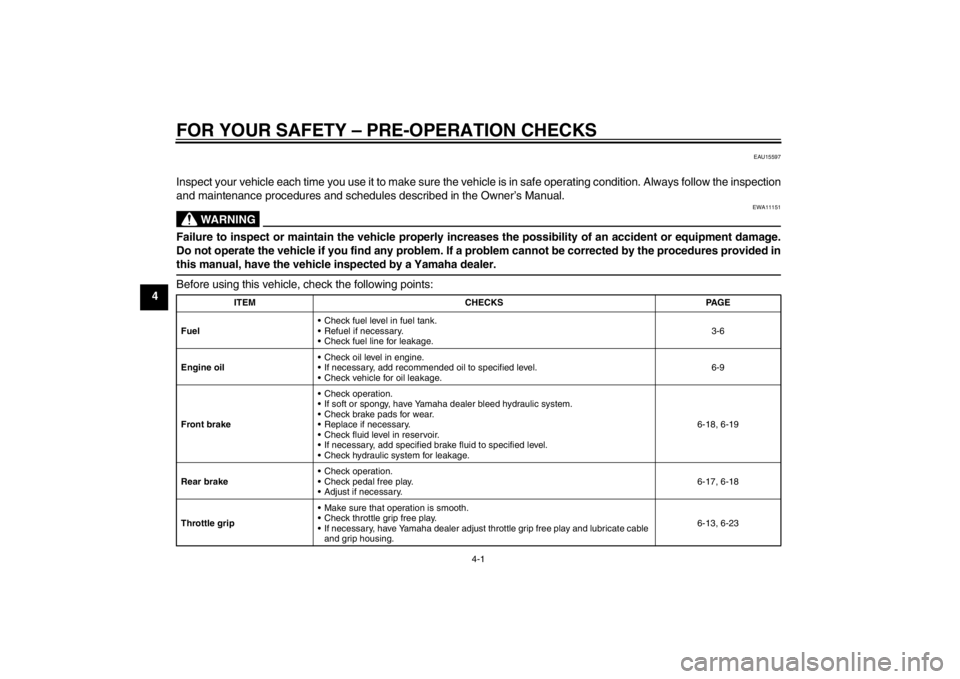
FOR YOUR SAFETY – PRE-OPERATION CHECKS
4-1
4
EAU15597
Inspect your vehicle each time you use it to make sure the vehicle is in safe operating condition. Always follow the inspection
and maintenance procedures and schedules described in the Owner’s Manual.
WARNING
EWA11151
Failure to inspect or maintain the vehicle properly increases the possibility of an accident or equipment damage.
Do not operate the vehicle if you find any problem. If a problem cannot be corrected by the procedures provided in
this manual, have the vehicle inspected by a Yamaha dealer.Before using this vehicle, check the following points:
ITEM CHECKS PAGE
Fuel Check fuel level in fuel tank.
Refuel if necessary.
Check fuel line for leakage.3-6
Engine oil Check oil level in engine.
If necessary, add recommended oil to specified level.
Check vehicle for oil leakage.6-9
Front brake Check operation.
If soft or spongy, have Yamaha dealer bleed hydraulic system.
Check brake pads for wear.
Replace if necessary.
Check fluid level in reservoir.
If necessary, add specified brake fluid to specified level.
Check hydraulic system for leakage.6-18, 6-19
Rear brake Check operation.
Check pedal free play.
Adjust if necessary.6-17, 6-18
Throttle grip Make sure that operation is smooth.
Check throttle grip free play.
If necessary, have Yamaha dealer adjust throttle grip free play and lubricate cable
and grip housing.6-13, 6-23
U40BE2E0.book Page 1 Wednesday, October 10, 2012 8:01 AM
Page 28 of 82
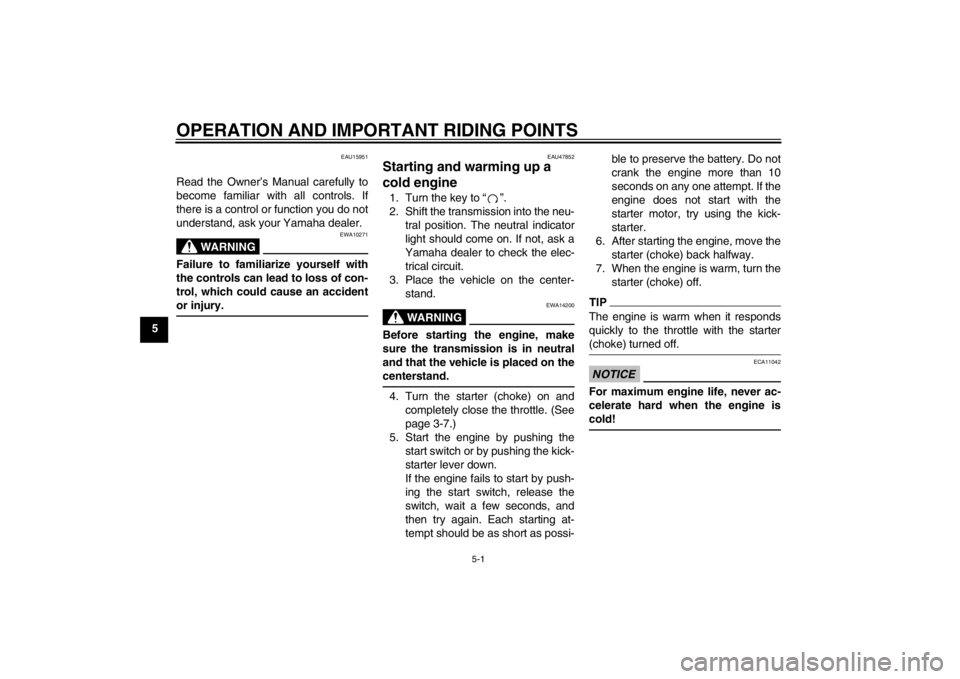
OPERATION AND IMPORTANT RIDING POINTS
5-1
5
EAU15951
Read the Owner’s Manual carefully to
become familiar with all controls. If
there is a control or function you do not
understand, ask your Yamaha dealer.
WARNING
EWA10271
Failure to familiarize yourself with
the controls can lead to loss of con-
trol, which could cause an accident
or injury.
EAU47852
Starting and warming up a
cold engine 1. Turn the key to “ ”.
2. Shift the transmission into the neu-
tral position. The neutral indicator
light should come on. If not, ask a
Yamaha dealer to check the elec-
trical circuit.
3. Place the vehicle on the center-
stand.
WARNING
EWA14200
Before starting the engine, make
sure the transmission is in neutral
and that the vehicle is placed on the
centerstand.4. Turn the starter (choke) on and
completely close the throttle. (See
page 3-7.)
5. Start the engine by pushing the
start switch or by pushing the kick-
starter lever down.
If the engine fails to start by push-
ing the start switch, release the
switch, wait a few seconds, and
then try again. Each starting at-
tempt should be as short as possi-ble to preserve the battery. Do not
crank the engine more than 10
seconds on any one attempt. If the
engine does not start with the
starter motor, try using the kick-
starter.
6. After starting the engine, move the
starter (choke) back halfway.
7. When the engine is warm, turn the
starter (choke) off.
TIPThe engine is warm when it responds
quickly to the throttle with the starter
(choke) turned off.NOTICE
ECA11042
For maximum engine life, never ac-
celerate hard when the engine is
cold!
U40BE2E0.book Page 1 Wednesday, October 10, 2012 8:01 AM
Page 29 of 82
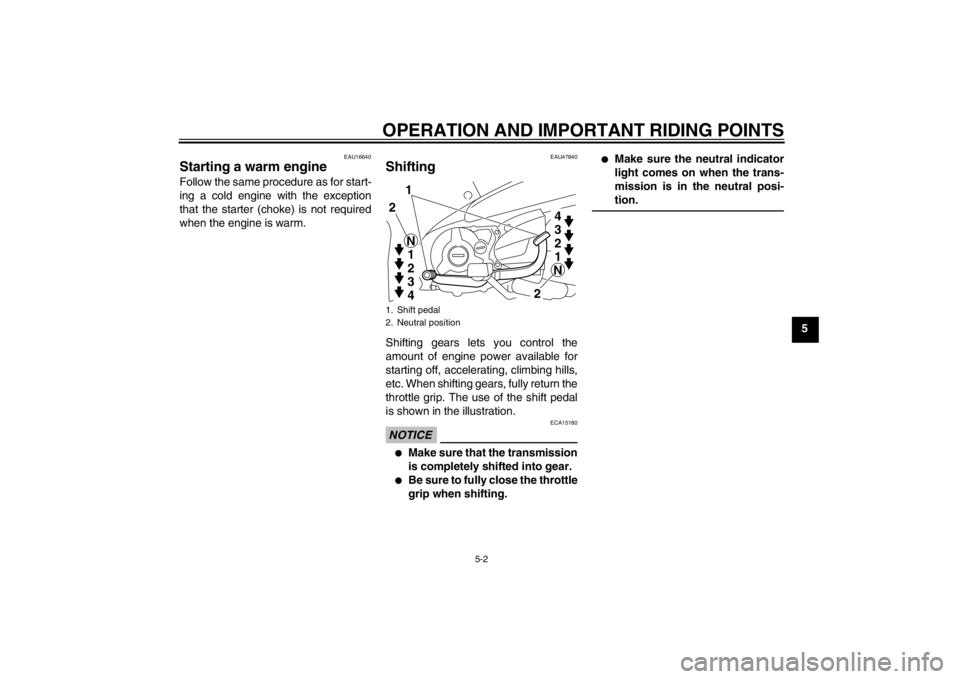
OPERATION AND IMPORTANT RIDING POINTS
5-2
5
EAU16640
Starting a warm engine Follow the same procedure as for start-
ing a cold engine with the exception
that the starter (choke) is not required
when the engine is warm.
EAU47840
Shifting Shifting gears lets you control the
amount of engine power available for
starting off, accelerating, climbing hills,
etc. When shifting gears, fully return the
throttle grip. The use of the shift pedal
is shown in the illustration.NOTICE
ECA15180
●
Make sure that the transmission
is completely shifted into gear.
●
Be sure to fully close the throttle
grip when shifting.
●
Make sure the neutral indicator
light comes on when the trans-
mission is in the neutral posi-
tion.
1. Shift pedal
2. Neutral position
1
2
21
2
3
4 N
N3
2
1 4
U40BE2E0.book Page 2 Wednesday, October 10, 2012 8:01 AM
Page 30 of 82
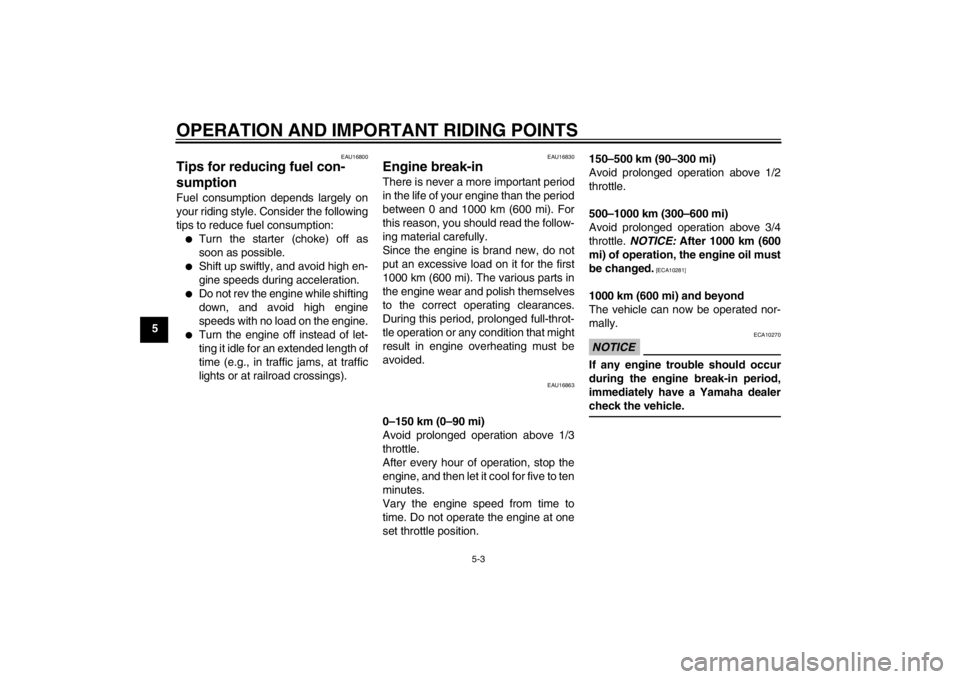
OPERATION AND IMPORTANT RIDING POINTS
5-3
5
EAU16800
Tips for reducing fuel con-
sumption Fuel consumption depends largely on
your riding style. Consider the following
tips to reduce fuel consumption:●
Turn the starter (choke) off as
soon as possible.
●
Shift up swiftly, and avoid high en-
gine speeds during acceleration.
●
Do not rev the engine while shifting
down, and avoid high engine
speeds with no load on the engine.
●
Turn the engine off instead of let-
ting it idle for an extended length of
time (e.g., in traffic jams, at traffic
lights or at railroad crossings).
EAU16830
Engine break-in There is never a more important period
in the life of your engine than the period
between 0 and 1000 km (600 mi). For
this reason, you should read the follow-
ing material carefully.
Since the engine is brand new, do not
put an excessive load on it for the first
1000 km (600 mi). The various parts in
the engine wear and polish themselves
to the correct operating clearances.
During this period, prolonged full-throt-
tle operation or any condition that might
result in engine overheating must be
avoided.
EAU16863
0–150 km (0–90 mi)
Avoid prolonged operation above 1/3
throttle.
After every hour of operation, stop the
engine, and then let it cool for five to ten
minutes.
Vary the engine speed from time to
time. Do not operate the engine at one
set throttle position.150–500 km (90–300 mi)
Avoid prolonged operation above 1/2
throttle.
500–1000 km (300–600 mi)
Avoid prolonged operation above 3/4
throttle. NOTICE: After 1000 km (600
mi) of operation, the engine oil must
be changed.
[ECA10281]
1000 km (600 mi) and beyond
The vehicle can now be operated nor-
mally.NOTICE
ECA10270
If any engine trouble should occur
during the engine break-in period,
immediately have a Yamaha dealer
check the vehicle.
U40BE2E0.book Page 3 Wednesday, October 10, 2012 8:01 AM
Page 31 of 82

OPERATION AND IMPORTANT RIDING POINTS
5-4
5
EAU17213
Parking When parking, stop the engine, and
then remove the key from the main
switch.
WARNING
EWA10311
●
Since the engine and exhaust
system can become very hot,
park in a place where pedestri-
ans or children are not likely to
touch them and be burned.
●
Do not park on a slope or on soft
ground, otherwise the vehicle
may overturn, increasing the
risk of a fuel leak and fire.
●
Do not park near grass or other
flammable materials which
might catch fire.
U40BE2E0.book Page 4 Wednesday, October 10, 2012 8:01 AM
Page 32 of 82

PERIODIC MAINTENANCE AND ADJUSTMENT
6-1
6
EAU17244
Periodic inspection, adjustment, and lu-
brication will keep your vehicle in the
safest and most efficient condition pos-
sible. Safety is an obligation of the vehi-
cle owner/operator. The most important
points of vehicle inspection, adjust-
ment, and lubrication are explained on
the following pages.
The intervals given in the periodic
maintenance charts should be simply
considered as a general guide under
normal riding conditions. However, de-
pending on the weather, terrain, geo-
graphical location, and individual use,
the maintenance intervals may need to
be shortened.
WARNING
EWA10321
Failure to properly maintain the ve-
hicle or performing maintenance ac-
tivities incorrectly may increase
your risk of injury or death during
service or while using the vehicle. If
you are not familiar with vehicle ser-
vice, have a Yamaha dealer perform
service.
WARNING
EWA15122
Turn off the engine when performing
maintenance unless otherwise
specified.●
A running engine has moving
parts that can catch on body
parts or clothing and electrical
parts that can cause shocks or
fires.
●
Running the engine while ser-
vicing can lead to eye injury,
burns, fire, or carbon monoxide
poisoning – possibly leading to
death. See page 1-3 for more in-
formation about carbon monox-
ide.WARNING
EWA15460
Brake discs, calipers, drums, and
linings can become very hot during
use. To avoid possible burns, let
brake components cool before
touching them.
EAU17302
Emission controls not only function to
ensure cleaner air, but are also vital to
proper engine operation and maximum
performance. In the following periodic
maintenance charts, the services relat-
ed to emissions control are grouped
separately. These services require
specialized data, knowledge, and
equipment. Maintenance, replacement,
or repair of the emission control devic-
es and systems may be performed by
any repair establishment or individual
that is certified (if applicable). Yamaha
dealers are trained and equipped to
perform these particular services.
U40BE2E0.book Page 1 Wednesday, October 10, 2012 8:01 AM
Page 34 of 82

PERIODIC MAINTENANCE AND ADJUSTMENT
6-3
6
EAU46871
TIP●
The annual checks must be performed every year, except if a kilometer-based maintenance, or for the UK, a
mileage-based maintenance, is performed instead.
●
From 30000 km (17500 mi), repeat the maintenance intervals starting from 6000 km (3500 mi).
●
Items marked with an asterisk should be performed by a Yamaha dealer as they require special tools, data and technical
skills.
EAU46920
Periodic maintenance chart for the emission control system NO. ITEM CHECK OR MAINTENANCE JOBODOMETER READING
ANNUAL
CHECK 1000 km
(600 mi)6000 km
(3500 mi)12000 km
(7000 mi)18000 km
(10500 mi)24000 km
(14000 mi)
1*Fuel line Check fuel and vacuum hoses for
cracks or damage.√√√√√
2 Spark plug Check condition.
Clean and regap.√√
Replace.√√
3*Valves Check valve clearance.
Adjust.√√√√
4*Carburetor Check starter (choke) operation.
Adjust engine idling speed.√√√√√√
5*Air induction sys-
tem Check the air cut-off valve, reed
valve, and hose for damage.
Replace any damaged parts if
necessary.√√√√√
U40BE2E0.book Page 3 Wednesday, October 10, 2012 8:01 AM
Page 36 of 82

PERIODIC MAINTENANCE AND ADJUSTMENT
6-5
6
9*Swingarm Check operation and for exces-
sive play.√√√√
Lubricate with lithium-soap-based
grease.Every 24000 km (14000 mi)
10 Drive chain Check chain slack, alignment and
condition.
Adjust and thoroughly lubricate
chain with engine oil.Every 500 km (300 mi) and after washing the motorcycle, riding in the rain or
riding in wet areas
11*Steering bearings Check bearing play and steering
for roughness.√√√√√
Lubricate with lithium-soap-based
grease.Every 24000 km (14000 mi)
12*Chassis fasteners Make sure that all nuts, bolts and
screws are properly tightened.√√√√√
13Brake lever pivot
shaft Lubricate with silicone grease.√√√√√
14Brake pedal pivot
shaft Lubricate with lithium-soap-based
grease.√√√√√
15Centerstand, side-
stand (for side-
stand-equipped
models) Check operation.
Lubricate with lithium-soap-based
grease.√√√√√
16*Front fork Check operation and for oil leak-
age.√√√√
17*Shock absorber as-
semblies Check operation and shock ab-
sorbers for oil leakage.√√√√ NO. ITEM CHECK OR MAINTENANCE JOBODOMETER READING
ANNUAL
CHECK 1000 km
(600 mi)6000 km
(3500 mi)12000 km
(7000 mi)18000 km
(10500 mi)24000 km
(14000 mi)
U40BE2E0.book Page 5 Wednesday, October 10, 2012 8:01 AM
Page 37 of 82
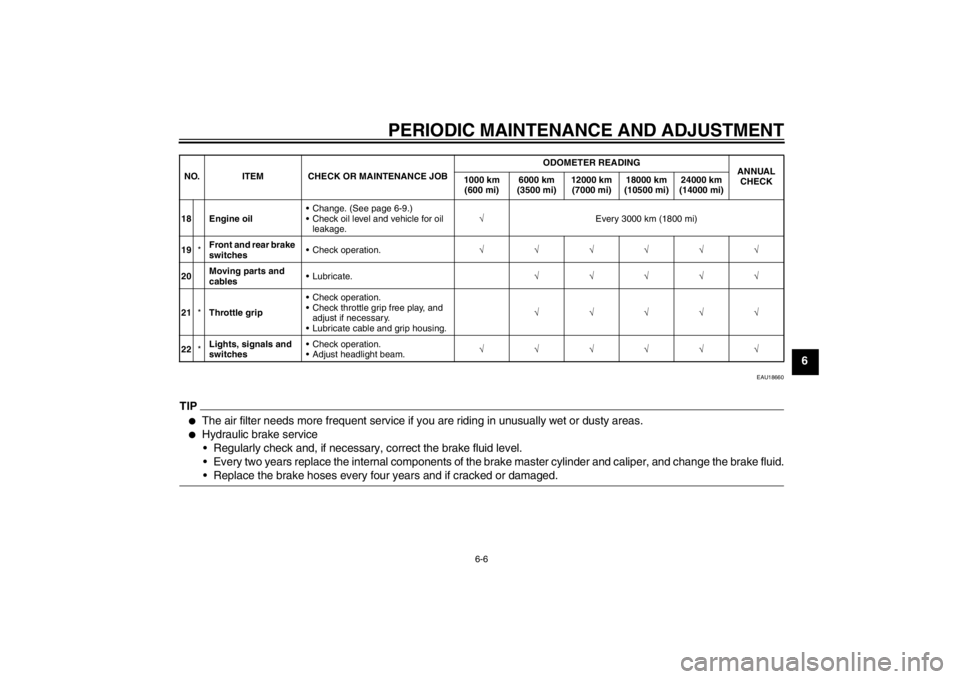
PERIODIC MAINTENANCE AND ADJUSTMENT
6-6
6
EAU18660
TIP●
The air filter needs more frequent service if you are riding in unusually wet or dusty areas.
●
Hydraulic brake service
Regularly check and, if necessary, correct the brake fluid level.
Every two years replace the internal components of the brake master cylinder and caliper, and change the brake fluid.
Replace the brake hoses every four years and if cracked or damaged.
18 Engine oil Change. (See page 6-9.)
Check oil level and vehicle for oil
leakage.√Every 3000 km (1800 mi)
19*Front and rear brake
switches Check operation.√√√√√√
20Moving parts and
cables Lubricate.√√√√√
21*Throttle grip Check operation.
Check throttle grip free play, and
adjust if necessary.
Lubricate cable and grip housing.√√√√√
22*Lights, signals and
switches Check operation.
Adjust headlight beam.√√√√√√ NO. ITEM CHECK OR MAINTENANCE JOBODOMETER READING
ANNUAL
CHECK 1000 km
(600 mi)6000 km
(3500 mi)12000 km
(7000 mi)18000 km
(10500 mi)24000 km
(14000 mi)
U40BE2E0.book Page 6 Wednesday, October 10, 2012 8:01 AM